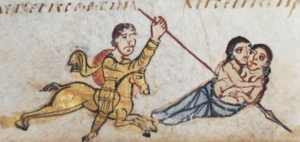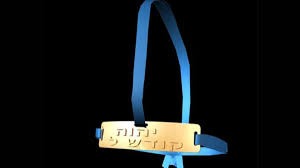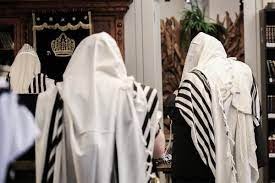The Golden Headband and the Virginity Test
Who knew that a headband -a golden one- worn on one’s head could determine virginity? We shall explore than below, ober we begin here. The ominous three weeks are in full bloom; the worst is yet to come as the nine days begin next week. Yikes! As mentioned in the past, bad stuff happens during the nine days. Not to everyone of course but keep one eye open!
This coming shabbis we will say goodbye to Sefer Bamidbar while listening to the back end of the Matos- Maseye double header. So happens that these two parshas are almost always read together, and are separated only when the year requires an extra shabbis reading, meaning that we ran out of shabosim to read the heylige Toirah. The bottom line: though we treat Matos and Masei as separate parshas, we should really view them as one long parsha (making the combination the largest parsha in the heylige Toirah. One more tidbit to make you look good at the shabbis tish: On the occasional years when Matos and Masei are read separately, Parshas Pinchas falls before the Three Weeks. In what years are Matos and Masei separated? Only in leap years and only when there are no parshas doubled together from Simchas Torah until the week before Rosh Hashono. Are you confused? Fuhgeddaboudit and let’s go Veyter.
Lots going on, much ground to cover including discussions about vows by girls and women and how to undo them; the war against the Midianites and how those in command did not -according to Moishe- execute the plan properly; the spoils of war and how to properly divide the booty; laws about kashering (the method by which a utensil that had been used with non-kosher food is rendered permissible for use). and toiveling (oft- time confused as being the same: they’re not); a shtikel breakaway by 2 ½ shevotim (tribes); a review and detailed listing of the Yiddin’s wanderings during the past 40 years; the command to conquer the Promised Land; very clear delineation of the boundaries of what we call Israel today; the appointment of leaders who will oversee the lottery system to be implemented when divvying up the Land; instructions for taking good care of the Leviyim (Levites) who nebech (sadly) weren’t to receive a real portion of the Land, and, finally but seemingly quite important, a discussion on the setting up of the various ‘Oray Miklat’ (cities of refuge), designated safe-houses, so to speak, for the inadvertent killer. Shoin: take a breath and exhale: we just covered two gantza (entire) parshas and a total of 244 pisukim in one long run-on sentence and paragraph.
Two weeks ago, Pinchas acted out on his zealotry and murdered a sinning Jew and his accomplice in the middle of an orgy. He speared them through their stomachs, which the heylige Gemora goes on to explain was a code word for their genitals, while they were belly to belly. He performed Pinchas-Interruptus and the magayfo (plague) the RBSO brought upon those who participated in the orgy was halted. Veyter. The RBSO shouted Pinchas out and gave him credit for stopping the plague. Sad endings followed happy endings, if you chap -which they seemingly did with and from the Moabite and Midianite hot shiksas. A week later, Pinchas was rewarded with his own parsha, ober things can change rather quickly and, in this week’s, parsha, our friend Pinchas is seemingly hero no more. How does one go from zero to hero and back in so short a time period? The three-week syndrome? In our parsha Pinchas gets tongue lashed by Moishe, and let’s begin by finding out why Moishe was all upset with General Pinchas and the army. Here’s what unfolded.

The RBSO ordered and declared war against the Midianites for their complicity and underhanded methods employed in seducing a good number of Yiddin – more than 24,000 of them- into sex acts with their daughters, rachmono litzlon (heaven forbid). When the war orders and battle instructions were given, the RBSO also told Moishe that this would be his final act as leader of the Yiddin and that he would pass away immediately thereafter. Not exactly great motivation for Moishe; not words that would cause him to act with zerizus (haste). Ober says Rashi azoy: Moishe sprang into immediate action. Moishe drafted 1,000 men from each sheyvet and shoin, an army of 12,000 was born. Did the army include chareidim, ver veyst? As an aside, the Ois is watching and highly recommends that you all watch Commandments (https://www.amazon.com/Commandments-Season-1/dp/B08244LGPM) on a subchannel of Amazon Prime. It’s amazing! In any event, do all agree that the army had 12,000 men or that every sheyvet participated? Avada nisht! There is of course a machloikes (disagreement) as to whether or not the Leviyim (Levites) participated in the war, or, instead hid out in some draft dodging yeshiva. Some say that the Leviyim did join the army since this was a war of revenge and avada when it comes to revenge; all are interested in serving and must.
Another medrish tells us that although the specific instructions called for 1,000 soldiers per tribe, the real instructions called for 3,000 men per tribe for a total of 36,000. And how do we reconcile these two numbers? Who says the numbers need to be reconciled? And what difference is it to you if each sheyvet sent 1000 or 3000? Nu, since it’s medrish, avada this isn’t much of an issue, ober one answer proffered tells us azoy: Taka there were 3,000 soldiers per sheyvet, ober of those, only 1,000 per tribe were real fighters. And the others? Seemingly, they were there for moral support which they showed by davening (praying) for the real soldiers to win the war. Shoin! Davening is at times seemingly also a job. Gishmak mamish and maybe a shtikel plan for dealing with the koill-yungeleight (willfully unemployed) over in Israel?
Is everyone tzifridden (satisfied) with this medrish? Not! Why would an army of 12,000 in total require an additional 24,000 daveners? Were they the gang that couldn’t shoot straight? Isn’t one good davener and shokeler enough to cover the entire army? Nu, mistama it depends on how well and in which directions one shokels and avada if the davener has his talis over his head or not. After all, isn’t that the hallmark of a good davener and shokeler? Moreover, that same medrish tells us that the 24,000 daveners also accompanied the Yiddin into the battlefield for moral support, ober some question why this was necessary. Isn’t the RBSO anywhere and everywhere? Why not daven in shul or in the midbar? Says R’ Chaim Shmuelevitz so gishmak azoy: emesdike davening (true prayer) can only be generated if one can feel deep empathy for the fellow Yid for whom one is praying. Without this key ingredient, the prayer will never be genuinely heartfelt. This is why, although the RBSO is everywhere, the davening Yiddin needed to be on location, on the battlefield, witnessing in real time, everything that their brothers were experiencing. Only then could they effectively pray for their brothers at arms. Gishmak mamish.
Back to General Pinchas who was appointed to lead the war. Avada you recall that he was adept with his spear. Some say he was appointed because of a tradition we Yiddin have to allow the person starting a mitzvah to also finish it. And since Pinchas began the mitzvah of avenging the RBSO’s honor by killing Kosbi the Midianite princess, he was rewarded with finishing the job and the Midianites; also gishmak mamish. The war was on: the Yiddin huben-gihargit (killed) all menner (males) including Bilam and five kings, ober the women, children, herds, flocks, and possessions of Midian were taken as booty. The cities and palaces were destroyed. Sounds like the mission was accomplished, but was it? Was Moishe happy? Seemingly not!
Moishe, Elozor, and other leaders went out to greet and congratulate the returning army. Avada he knew they were going to win the war by killing their enemies because this particular war was a war of revenge, so ordered by the RBSO Himself. And when the RBSO orders war, one needn’t worry about the mission or its outcome. Ober, the question is this: why taka was the RBSO so upset with the Midianites? Seemingly He was still upset over their role in the sex games in which the Midianites and Moabite meydlich (girls) entrapped the hapless Yiddin into mishuga sex acts coupled with the ever-dangerous avoido-zoro-always a lethal combo- leading to the death of 24,000 Yiddin before Pinchas took matters into his own hands.
Says the Ohr HaChaim so gishmak azoy: Midian represents physical lusting, (no kidding)! They have to be seen as evil and needed to be destroyed. Moishe would then know that the Yiddin were ready to cross the Jordan and into the land. Ober, what did Pinchas and the Yiddin do during the war? Did they kill the veyber, those very women that caused such a shande (embarrassment), and angered the RBSO so? A necthiger tug (fuhgeddaboudit): Instead, they killed the men only, took the booty and let the women off the hook. And Pinchas did this why? Is it that Pinchas had, or didn’t, have hard feelings for these women, if you chap? Was Pinchas soft when he was supposed to be hard? Taka a problem! We are taught that the troops and their general (Pinchas) made a cheshboin (reasoning) that since women did not participate in the battle, they were but innocent bystanders and were not deserving of death. Moreover, efsher they thought that these fine women still had what to contribute to society and to the Yiddin, if you chap. Efsher they planned a shtikel reunion, ver veyst?
The bottom line: Moishe was not at all tzifridden (happy) that the officers gave the women of Midyan a pass since it was mamish women that were instrumental in uprising-if you chap and downfall of the Yiddin in the Pe’or affair and the consequent plague. Nor was he happy about the children being spared and though Pinchas and his commanders figured that the young males would make good slaves, Moishe reprimanded them mamish. His thinking was that the males would grow up and threaten the Yiddin while the women were all whores and had been the only cause -of the immorality, and the idolatry of the hapless Yiddin. Shoin! What to do? Moishe ordered the Yiddin to go back and wipe out all males, and the women. Let’s read the posik innavenyig and then let’s try deciphering what the words were meant to convey. Says the heylige Toirah 31:17 azoy:
וְעַתָּ֕ה הִרְג֥וּ כׇל־זָכָ֖ר בַּטָּ֑ף וְכׇל־אִשָּׁ֗ה יֹדַ֥עַת אִ֛ישׁ לְמִשְׁכַּ֥ב זָכָ֖ר הֲרֹֽגוּ׃
Now, therefore, slay every male among the noncombatants, and slay also every woman who has known a man carnally. Let’s read one more, posik 18, which says azoy: וְכֹל֙ הַטַּ֣ף בַּנָּשִׁ֔ים אֲשֶׁ֥ר לֹא־יָדְע֖וּ מִשְׁכַּ֣ב זָכָ֑ר הַחֲי֖וּ לָכֶֽם׃
But spare every female noncombatant who has not had carnal relations with a man.

What? Carnal knowledge? What’s that? Says Wikipedia -who as an aside knows almost as much as does Rashi, azoy: Carnal knowledge is an archaic or legal euphemism for sexual intercourse. In modern statutes, the term “sexual penetration ” is widely used, though with various definitions. And now you know. Grada, when the Ois was growing up, the term “mishkav zochor” referred to gay sex, to homosexuals engaging in intercourse. Cleary that’s not what the heylige Toirah is referring to. Moreover, in hyntige tzeytin (todays times) it’s hard to know what a zochor is. Some say it’s all about how one identifies; noch a mishigas that will ultimately cause the RBSO to again – as in Noiach’s times- destroy the world.
The bottom line: the instructions state that Pinchas was to kill all women who has known a man carnally. What’s going on here? Nu, this very question was also on the mind of many an exegete and let’s read what a few had to say. Says Rashi referencing the medrish (Sifrei Bamidbar 157:6) on the words – וכל אשה ידעת איש (AND EVERY WOMAN WHO KNOWS MAN) — i.e., who is fitted for cohabitation, even though she has never experienced it. No penetration necessary. But listen to this: As a test they made them (the women) pass in front of the Golden Plate, and if anyone was fitted for cohabitation her face turned green. Face turned green? The golden plate? What the hec is going on here?
Shoin, let us harken back to Sefer Shmois where we were first introduced to the tzitz and these instructions. Make a plate (tzitz) of pure gold, and engrave on it as on a seal, “Holy to Hashem.” Place it upon a blue thread, so that it will be on the turban; it shall be opposite the front of the turban. It will be on Aharoin’s forehead, and Aharoin will absolve the guilt of the holy things which the children of Israel sanctify, all of their holy offerings; it shall be on his forehead constantly, for their acceptance before G‑d. The pisukim quoted state that Aharoin used the tzitz to “absolve the guilt of the holy things.” Says Rashi, that offerings in the Holy Temple had to be brought in a state of ritual purity. If either the offering itself or the koihen (priest) performing the service was impure, then the offering would be disqualified and the koihen would be guilty of a transgression.
 Ober, in certain cases where an offering was brought in a state of impurity, the tzitz made it acceptable to the RBSO. Says the heylige Zoihar azoy: the koihen godol could observe whether the words inscribed on the tzitz, “Holy to G‑d,” were reflected on the face of the person standing before him. If so, that meant that the person was righteous and deserving of a share in the world to come. If not, then the kohen Godol knew that he was impudent, and the high priest would pray for the RBSO to have mercy on the wicked person and forgive him. The bottom line: it appears that the Tzitz had magical powers which seemingly extended to ascertaining virginity from carnal knowledge. How that worked, ver veyst? Why is stopped working is a topic for another day.
Ober, in certain cases where an offering was brought in a state of impurity, the tzitz made it acceptable to the RBSO. Says the heylige Zoihar azoy: the koihen godol could observe whether the words inscribed on the tzitz, “Holy to G‑d,” were reflected on the face of the person standing before him. If so, that meant that the person was righteous and deserving of a share in the world to come. If not, then the kohen Godol knew that he was impudent, and the high priest would pray for the RBSO to have mercy on the wicked person and forgive him. The bottom line: it appears that the Tzitz had magical powers which seemingly extended to ascertaining virginity from carnal knowledge. How that worked, ver veyst? Why is stopped working is a topic for another day.
Shoin, let’s turn back to the heylige Gemora (Yevomis 60b), which tells us azoy: The command was not just to slay those women who had actually had intercourse mamish, but also to kill anyone that was “fit for intercourse.” How does one get ‘fit’ for intercourse? Says the heylige Gemora: it’s a technical term within halocho (Jewish law) that intercourse at a specific age is considered intercourse, whereas at an earlier age, the act is not called intercourse. If she wasn’t fit, Pinchas could acquit! And what is that age?

Says the Chizkuni ‘וכל הטף בנשים אשר לא ידעו איש וגו, “but any children among the women who have not had carnal knowledge, etc.” you shall let live for your benefit. This formulation prompted Rebbe Shimon ben Yochai to state that a female convert who has not attained the age of three years and a day, is fit to marry a priest. (as she could not have been contaminated through carnal intercourse). And now you know; and blow me down! Mamish shreklich (OMG)!
Let’s also read this pshat from Rabaynu Bechaya who says this: וכל אשה יודעת איש למשכב זכר הרגו, “and every woman fit to know a man by lying with a male, you shall kill.” After Moishe had started by saying: “kill every male minor, he now added separately: “kill the women, etc.” There is a reason that he had to use the word: “kill” twice. If the Toirah had only written: “kill every male minor,” I would have thought that the second half of the verse i.e. “all the female minors who have not slept with a man you may let live,” included even females who were old enough to sleep with men but had not done so. In order to avoid such misunderstanding the Toirah inserted the word הרגו at the end of verse 17 to separate these two categories of female minors. On the other hand, if the Toirah had only written verse 18, the meaning of the instruction would have been: ועתה כל זכר בטף וכל אשה יודעת איש למשכב זכר וגו’, “and now every male minor and every female minor old enough to lie with a male, etc.” would have meant that males above the age of nine years (when they are perceived as capable of intercourse) had to be killed. This is why these instructions had to be worded the way they were to avoid misunderstanding. Male children, even if infants, had to be killed (Sifri).
You may well ask how the Yiddin could determine which child fitted which criterion? We are told in Yevomis 60 that each child walked past the Koihen Godol (High Priest) wearing his golden headband -the ציץ- whereupon the faces of the girls who had had sexual experience turned green. This is the reason we were taught that a disease called דרקון is an indication that the afflicted person was an idolater. According to some, examination by walking by the ציץ was effective only for Gentiles, whereas Jewish girls would be seated on a wine casket if one wanted to determine their virginity. If a certain odor would be emitted this was considered proof that the girl in question was not a virgin.
Ober, Rav Kahana derived the inadmissibility of the ציץ test for Jewish girls from Shmois 28,38 where the Toirah describes the function of the golden headband as “it shall be on his forehead (High Priest) always, to bring them favor before Hashem.” The function of the ציץ did not include incriminating Jewish girls. Rav Ashi added that the word להם in that verse extends the beneficial function of said golden headband to Israelites only.
Some of you may be wondering why the RBSO waged war against the Midianites when it was the Moabites that supplied the whores that enticed and seduced the Yiddin; what’s taka pshat? Ober we should never question the RBSO because avada He knows best and although the women of both Moiav and Midyan were involved in the plot to seduce the unsuspecting men, the war of revenge is described as being against Midyan alone. Taka why? Says the heylige Gemora (Buba Kamma) azoy: the Moabite daughters were forced by Bolok to have sex with the Yiddin ober the Midianite daughters of Bilam did so willingly. Accordingly, the RBSO gave specific order to kill the Midianite shiksas and for the Moabite women to be spared. Moreover, we must avada keep in mind that our favorite of all Jewish heroines, Rus (Ruth), she, the maternal grandmother of the Davidic kingship and dynasty- was a Moabitess. And had Moishe ordered that all of the Moabites be killed, how would Dovid Hamelech ever have come to be? And how would the Moshiach, he a decedent mamish, ever be born? Shoin, as you can see, the RBSO had a plan. Sometimes it takes years to see it.
 And says the medrish azoy: The Moabites were not so giferlich after all, mistama they threw a good party. They were driven by their sexual lust only, whereas those Midianite whores were doing the old bait and switch routine, forcing their clients to perform avoido-zoro (idolatry) for their god as well. Chap that? In other words: sex alone is nisht giferlich, ober sex coupled with avoido zoro is mamish like speaking loshoin horo with the talis over the head and is disgusting mamish.
And says the medrish azoy: The Moabites were not so giferlich after all, mistama they threw a good party. They were driven by their sexual lust only, whereas those Midianite whores were doing the old bait and switch routine, forcing their clients to perform avoido-zoro (idolatry) for their god as well. Chap that? In other words: sex alone is nisht giferlich, ober sex coupled with avoido zoro is mamish like speaking loshoin horo with the talis over the head and is disgusting mamish.
A gittin Shabbis-
The Heylige Oisvorfer Ruv
Yitz Grossman
